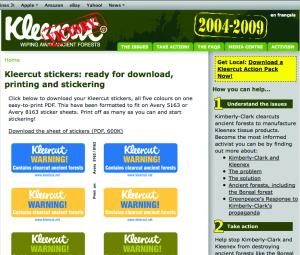TACTIC 6: CASE STUDY
UNDERSTAND YOUR CONNECTIONS
manage your contacts
download this tactic card (pdf 796kb)

Case Study
| TITLE: WHO: WHERE: WEBSITE: |
Kleercut Greenpeace North America Kleercut campaign website |
DESCRIPTION
Kleercut is a campaign implemented by Greenpeace to end the use of virgin wood fibre in Kimberly-Clark products. CiviCRM was used to collect contact information from people who visited the Kleercut website and to send them email alerts once or twice a month. In these alerts, people were asked to take an action, for example, to return to the Kleercut website to send a targeted email to Kimberly-Clark shareholders, or to attend a direct action near them. Kleercut also connected advocates to one another, allowing them to create regional and city-based email lists that they managed themselves. Richard Brooks who worked on the campaign says, "We couldn’t organise every protest in every town and city, so it was important to give people tools to self-organise. Instead of five campaigners, we had 10,000 people able to do things in the physical world because of tools we made available: a Kleercut action pack, a toolbook, posters, media releases." CiviCRM was used to track people’s engagement and Kleercut could see that 15-20% of the people it emailed took a follow-up action – "a higher response rate than the general Greenpeace list," says Richard. In August 2009, the Kleercut campaign ended successfully when Kimberly-Clark agreed to introduce standards for fibre content in its products.
| TOOLS USED: | Drupal for the website and CiviCRM to manage contacts. Richard says: "As more tools became available, like Facebook, YouTube, MySpace and Twitter, we started using those as well." |
| REACH: | Over five years of the campaign, 30,000 people signed up, with most in North America. Website was available in English and French. |
| RESOURCES: | Once publishing and contact management tools were launched, there was no additional significant cost to support the technology behind the campaign. "A lot of the web content – stories, blogs, and action items – 80% of that was done by campaigners," says Richard. |
| TIME: | 4 to 5 months to implement and customise website and constituent management systems. Campaign launched November 2004, ended August 2009. |
LEVEL Of DIFFICULTY: 3 out of 5
COST: Several thousand US dollars for outside contractors to create the website, integrate Drupal and CiviCRM, and design logo. Web hosting cost USD$50-$60 per month. Plus ongoing staff costs to manage and implement the project.
LINKS TO LEARN MORE: